

Asking the Right Questions. Albert Einstein is often quoted (perhaps apocryphally) as saying, “If I had 20 days to solve a problem, I would spend 19 days to define it.”
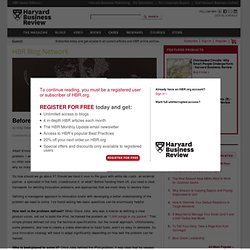
Innovation is a particularly sticky problem because it so often remains undefined. We treat it as a monolith, as if every innovation is the same, which is why so many expensive programs end up going nowhere. Wicked problems. Wicked problems. Wicked problem. 20 Points to Help You Solve Problems. The Art of Complex Problem Solving. How To Think Critically and Problem Solve. The quote by Jean De La Bruyere: "Life is a tragedy for those who feel, and a comedy for those who think," may seem a bit radical, however, according to the premise of cognitive psychology, what you think is what you feel.

While many people believe that your feelings precede, or are independent of your thoughts, the truth is that your feelings are products of your thoughts. This revelation can be both daunting and liberating. Daunting because it makes us responsible for our attitudes and liberating because we have the power to choose our perspective, mood and thoughts. When we are aware that we can choose and direct our thinking, we realize that we have the ability to better control the circumstances of our lives, improve our decision-making processes and generally live more productive lives.
This in no way suggests that we need downplay the many feelings and emotions we as humans enjoy, it's a simply a way for us to manage and balance them with our cognitive abilities. Critical Thinking and Problem-solving. Critical Thinking What is Critical Thinking?

When examining the vast literature on critical thinking, various definitions of critical thinking emerge. Problem Solving & Decision Making - Kepner-Tregoe. Analytical Thinking: Why You Need It and How to Get Better. Analytical thinking skills are critical in the work place because they help you to gather information, articulate, visualize and solve complex problems.
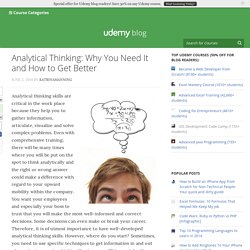
Even with comprehensive training, there will be many times where you will be put on the spot to think analytically and the right or wrong answer could make a difference with regard to your upward mobility within the company. You want your employees and especially your boss to trust that you will make the most well-informed and correct decisions. Some decisions can even make or break your career. Therefore, it is of utmost importance to have well-developed analytical thinking skills. However, where do you start? Analytical Vs. Some people make the assumption that analytical thinking and critical thinking are one in the same. When you think critically, you make the decision whether or not an event, an object or situation appears to be right or wrong.
Developing Analytical Skills. Root cause analysis. Root cause analysis (RCA) is a method of problem solving used for identifying the root causes of faults or problems.[1] A factor is considered a root cause if removal thereof from the problem-fault-sequence prevents the final undesirable event from recurring; whereas a causal factor is one that affects an event's outcome, but is not a root cause.
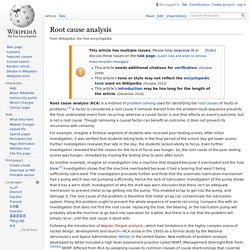
Though removing a causal factor can benefit an outcome, it does not prevent its recurrence with certainty. For example, imagine a fictional segment of students who received poor testing scores. After initial investigation, it was verified that students taking tests in the final period of the school day got lower scores. Further investigation revealed that late in the day, the students lacked ability to focus. Ishikawa diagram. Ishikawa diagrams (also called fishbone diagrams, herringbone diagrams, cause-and-effect diagrams, or Fishikawa) are causal diagrams created by Kaoru Ishikawa (1968) that show the causes of a specific event.[1][2] Common uses of the Ishikawa diagram are product design and quality defect prevention, to identify potential factors causing an overall effect.

Each cause or reason for imperfection is a source of variation. Causes are usually grouped into major categories to identify these sources of variation. The categories typically include: Overview[edit] Ishikawa diagram, in fishbone shape, showing factors of Equipment, Process, People, Materials, Environment and Management, all affecting the overall problem. Ishikawa diagrams were popularized by Kaoru Ishikawa[3] in the 1960s, who pioneered quality management processes in the Kawasaki shipyards, and in the process became one of the founding fathers of modern management. Causes[edit] Causes can be derived from brainstorming sessions. Assumption surfacing and testing.
It is all too easy to treat the routines or rules which we use in certain types of situation as inevitable and ordained.
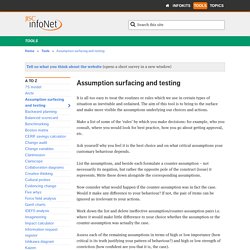
The aim of this tool is to bring to the surface and make more visible the assumptions underlying our choices and actions. Make a list of some of the ‘rules’ by which you make decisions: for example, who you consult, where you would look for best practice, how you go about getting approval, etc. Five Whys Tool for Root Cause Analysis. 5 Whys. The 5 Whys is an iterative question-asking technique used to explore the cause-and-effect relationships underlying a particular problem.[1] The primary goal of the technique is to determine the root cause of a defect or problem.
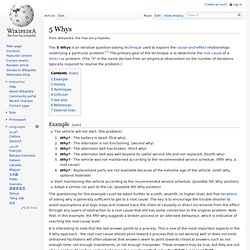
(The "5" in the name derives from an empirical observation on the number of iterations typically required to resolve the problem.) Example[edit] The vehicle will not start. An Introduction to 5-why. Learn how to find root causes of a problem by using 5-why analysis, so you can fix the issues where it matters most.
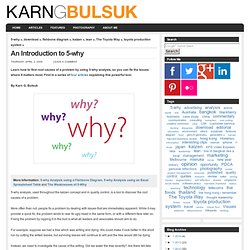
First in a series of four articles explaining this powerful tool. By Karn G. 5-whys Analysis using an Excel Spreadsheet Table. Find out how to visualize your five-whys analysis by putting it into a spreadsheet, including a downloadable five why template and tutorial.

Part 2 of a four part series on 5-whys. By Karn G. Bulsuk.